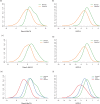A better screening tool for HIV-associated neurocognitive disorders: is it what clinicians need?
- PMID: 25291105
- PMCID: PMC4444425
- DOI: 10.1097/QAD.0000000000000152
A better screening tool for HIV-associated neurocognitive disorders: is it what clinicians need?
Abstract
Objective: Existing screening tools for HIV-Associated Neurocognitive Disorders (HAND) may lack the accuracy required for clinical use. We hypothesized that the diagnostic accuracy of the Montreal Cognitive Assessment (MoCA) as a screening tool for HAND might be improved with a stronger scoring methodology.
Design: Two hundred HIV-positive participants aged 18-65 years completed the MoCA and a battery of neuropsychological tests.
Methods: HAND diagnosis was established according to the Frascati criteria, and an NPZ-8 score was also calculated. Rasch analysis was applied to the MoCA items to create a quantitative score.
Results: The optimal cut-off on the quantitative MoCA for detecting impairment as per Frascati criteria yielded a sensitivity of 0.74 and a specificity of 0.68. Overall accuracy was 0.79 (95% CI: 0.73-0.85), an improvement over standard scoring methods. However, whether cognition was quantified with the quantitative MoCA or with NPZ-8, there was substantial overlap between diagnostic categories; several individuals categorized as impaired had better overall cognitive function as assessed by NPZ-8 or quantitative MoCA than those classified as normal using standard criteria.
Conclusion: Quantifying performance on MoCA items through Rasch analysis improves its accuracy as a screening tool for HAND, and demonstrates that cognition can be measured as a unidimensional construct in HIV, at least at the level of precision of bedside testing. However, the current categorical diagnostic approach to HAND is poorly aligned with summary measures of cognitive ability. Measuring cognition as a quasi-continuous construct may be more relevant than conventional HAND diagnostic categories for many clinical purposes.
Figures
Similar articles
-
Screening for neurocognitive impairment in HIV-positive adults aged 50 years and older: Montreal Cognitive Assessment relates to self-reported and clinician-rated everyday functioning.J Clin Exp Neuropsychol. 2017 Nov;39(9):842-853. doi: 10.1080/13803395.2016.1273319. Epub 2017 Jan 26. J Clin Exp Neuropsychol. 2017. PMID: 28122474 Free PMC article.
-
Neuropsychological screening tools in Italian HIV+ patients: a comparison of Montreal Cognitive Assessment (MoCA) and Mini Mental State Examination (MMSE).Clin Neuropsychol. 2016 Jan-Dec;30(sup1):1457-1468. doi: 10.1080/13854046.2016.1183048. Epub 2016 May 16. Clin Neuropsychol. 2016. PMID: 27180611
-
Montreal Cognitive Assessment (MoCA) for HIV-Associated Neurocognitive Disorders.Neuropsychol Rev. 2019 Sep;29(3):313-327. doi: 10.1007/s11065-019-09412-9. Epub 2019 Aug 22. Neuropsychol Rev. 2019. PMID: 31440882
-
Prevalence of HIV-associated neurocognitive disorder (HAND) in Turkey and assessment of Addenbrooke's Cognitive Examination Revised (ACE-R) test as a screening tool.HIV Med. 2021 Jan;22(1):60-66. doi: 10.1111/hiv.12957. Epub 2020 Sep 23. HIV Med. 2021. PMID: 32964651
-
Neurocognitive assessment in the diagnosis of HIV-associated neurocognitive disorders.Semin Neurol. 2014 Feb;34(1):21-6. doi: 10.1055/s-0034-1372339. Epub 2014 Apr 8. Semin Neurol. 2014. PMID: 24715485 Review.
Cited by
-
Understanding and optimizing brain health in HIV now: protocol for a longitudinal cohort study with multiple randomized controlled trials.BMC Neurol. 2016 Jan 14;16:8. doi: 10.1186/s12883-016-0527-1. BMC Neurol. 2016. PMID: 26762403 Free PMC article.
-
A Comparison of Five Brief Screening Tools for HIV-Associated Neurocognitive Disorders in the USA and South Africa.AIDS Behav. 2016 Aug;20(8):1621-31. doi: 10.1007/s10461-016-1316-y. AIDS Behav. 2016. PMID: 26860536 Free PMC article.
-
Monitoring HIV-Associated Neurocognitive Disorder Using Screenings: a Critical Review Including Guidelines for Clinical and Research Use.Curr HIV/AIDS Rep. 2017 Jun;14(3):83-92. doi: 10.1007/s11904-017-0349-9. Curr HIV/AIDS Rep. 2017. PMID: 28284004 Review.
-
Mental Health and Cognitive Performance Among Older People Living with HIV in Georgia.Ethn Dis. 2025 May 7;35(2):73-82. doi: 10.18865/EthnDis-2024-17. eCollection 2025 May. Ethn Dis. 2025. PMID: 40386068
-
Targeting the Brain Reservoirs: Toward an HIV Cure.Front Immunol. 2016 Sep 30;7:397. doi: 10.3389/fimmu.2016.00397. eCollection 2016. Front Immunol. 2016. PMID: 27746784 Free PMC article. Review.
References
-
- Ciccarelli N, Fabbiani M, Colafigli M, Trecarichi EM, Silveri MC, Cauda R, et al. Revised central nervous system neuropenetration-effectiveness score is associated with cognitive disorders in HIV-infected patients with controlled plasma viraemia. Antivir Ther 2013; 18:153–160. - PubMed
-
- Simioni S, Cavassini M, Annoni JM, Rimbault Abraham A, Bourquin I, Schiffer V, et al. Cognitive dysfunction in HIV patients despite long-standing suppression of viremia. AIDS 2010; 24:1243–1250. - PubMed
-
- Heaton RK, Marcotte TD, Mindt MR, Sadek J, Moore DJ, Bentley H, et al. The impact of HIV-associated neuropsychological impairment on everyday functioning. J Int Neuropsychol Soc 2004; 10:317–331. - PubMed
Publication types
MeSH terms
Grants and funding
LinkOut - more resources
Full Text Sources
Medical




